|
 Swiss
Arms Research Report, 2003 Swiss
Arms Research Report, 2003
By Derek Wassom
ARMA Scholar
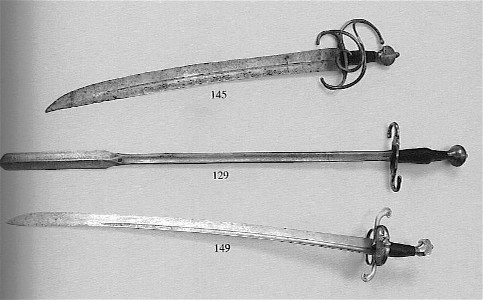 In
August 2003, I was lucky enough to do some hands-on study with antique
Medieval weaponry and it was an experience that was as enlightening
as it was splendid. I advise everyone who is studying Western Martial
Arts or anyone with an interest in European martial history to try
when ever the opportunity arises to handle these beautiful and elegant,
yet effective and deadly objects. Doing so will give you an opportunity
to acquire more understanding of how these weapons could be used,
and also that the modern replicas have a long way to go before they
can even compare to these wonderful and complex instruments of war. In
August 2003, I was lucky enough to do some hands-on study with antique
Medieval weaponry and it was an experience that was as enlightening
as it was splendid. I advise everyone who is studying Western Martial
Arts or anyone with an interest in European martial history to try
when ever the opportunity arises to handle these beautiful and elegant,
yet effective and deadly objects. Doing so will give you an opportunity
to acquire more understanding of how these weapons could be used,
and also that the modern replicas have a long way to go before they
can even compare to these wonderful and complex instruments of war.
The place I visited was the Fischer Auction House in Luzern,
Switzerland, which has a large arms and armor auction about every
year. I was first made aware of the Fischer by reading John
Clements' report of his
research visit in 1997.
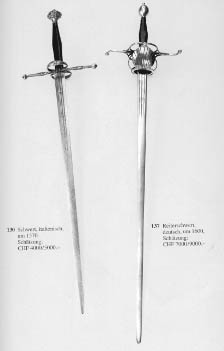 As
soon as I walked into the place I was completely blown away by the
amount of weaponry and armor available to see, touch, smell, and bid
for their September, 2003 auction. From bronze spearheads, to assault
rifles, they had it all. There were hundreds of pole-weapons from
the thirteenth to the seventeenth century from all regions of the
world. Halberds, spears, pikes, lances, bills, partisans, Luzern hammers,
spiedos, and poll axes were covering the walls on two floors. Their
armor ranged from a bronze helm from 1800 BC to twentieth century
military helmets. Sadly, I was unable to see many of the older items;
because they did not have them in the building at the time (the items
were not to become public until the eleventh of September). There
also were swords of all shapes, sizes and countries ranging from 1400
BC up until present-day military sabers. There were so many smallswords
on-hand I didn't have near enough time to see them all. Dr. Rudolf
Beglinger (the gentleman running the shop) allowed me to handle, measure,
and photograph any pieces I wanted, but I was on a time schedule so
I didn't get to as much as I would have liked. I concentrated most
of my time on six different swords, unfortunately not as thoroughly
as I would have liked. As
soon as I walked into the place I was completely blown away by the
amount of weaponry and armor available to see, touch, smell, and bid
for their September, 2003 auction. From bronze spearheads, to assault
rifles, they had it all. There were hundreds of pole-weapons from
the thirteenth to the seventeenth century from all regions of the
world. Halberds, spears, pikes, lances, bills, partisans, Luzern hammers,
spiedos, and poll axes were covering the walls on two floors. Their
armor ranged from a bronze helm from 1800 BC to twentieth century
military helmets. Sadly, I was unable to see many of the older items;
because they did not have them in the building at the time (the items
were not to become public until the eleventh of September). There
also were swords of all shapes, sizes and countries ranging from 1400
BC up until present-day military sabers. There were so many smallswords
on-hand I didn't have near enough time to see them all. Dr. Rudolf
Beglinger (the gentleman running the shop) allowed me to handle, measure,
and photograph any pieces I wanted, but I was on a time schedule so
I didn't get to as much as I would have liked. I concentrated most
of my time on six different swords, unfortunately not as thoroughly
as I would have liked.
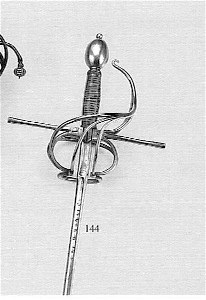 The
six swords I chose were two rapiers, two sabers, and two longswords/bastard-swords.
The first sword I examined was a beautiful swept-hilt rapier from
Germany. circa 1620/30. This was a wonderful sword. It was light in
my hand, and it was extremely well balanced. It felt like an extension
of my body, without having to first "get used to it". I
could feel its thrusting ability. I didn't want to thrust with it;
it wanted to thrust all on its own. The hilt was flawless with beautiful
flowing rings, straight quillons, and a wire wrap grip. The quillons
came to "trumpeted" ends that were hexagonal in cross-section.
The wrap was braided steel with metal slats along the sides, and felt
very comfortable in my hand. The blade was long and thin, rigid, had
no edge, and it came to a pencil point. I measured its thickness and
width along three points of blade. [See sketch 144]. The over-all
length was 111cm. I didn't have any device to weigh this specimen,
but I would estimate it to be around 1-2lbs. By the way….bidding
started at only $2000. The
six swords I chose were two rapiers, two sabers, and two longswords/bastard-swords.
The first sword I examined was a beautiful swept-hilt rapier from
Germany. circa 1620/30. This was a wonderful sword. It was light in
my hand, and it was extremely well balanced. It felt like an extension
of my body, without having to first "get used to it". I
could feel its thrusting ability. I didn't want to thrust with it;
it wanted to thrust all on its own. The hilt was flawless with beautiful
flowing rings, straight quillons, and a wire wrap grip. The quillons
came to "trumpeted" ends that were hexagonal in cross-section.
The wrap was braided steel with metal slats along the sides, and felt
very comfortable in my hand. The blade was long and thin, rigid, had
no edge, and it came to a pencil point. I measured its thickness and
width along three points of blade. [See sketch 144]. The over-all
length was 111cm. I didn't have any device to weigh this specimen,
but I would estimate it to be around 1-2lbs. By the way….bidding
started at only $2000.
|
|
|
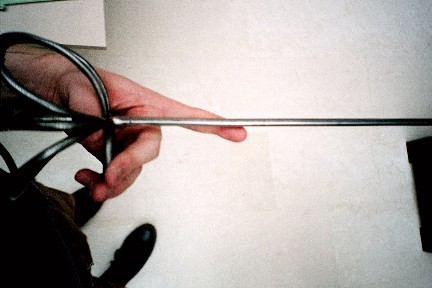 |
|
 The
second sword I examined was an Italian cup-hilt rapier. circa 1650.
I never was a fan of cup-hilts, but this has completely changed my
mind. The decorative work on the cup, quillons, knuckle guard, and
pommel were exquisite. The pictures do not do it justice. The weight
was about the same as the first rapier I handled, but it seemed quicker,
with the balance point closer to the hilt. The edgeless blade was
longer and thicker, and more flexible in comparison, but it tapered
more rapidly to an even more acute point. [See sketch 154]. The "edge"
had some trauma to it, but it looked too recent, as though the previous
owner had whacked it about some. Like the first one, this sword felt
alive in my hands, and "wanted" to thrust by itself. Bidding
started at $7000. The
second sword I examined was an Italian cup-hilt rapier. circa 1650.
I never was a fan of cup-hilts, but this has completely changed my
mind. The decorative work on the cup, quillons, knuckle guard, and
pommel were exquisite. The pictures do not do it justice. The weight
was about the same as the first rapier I handled, but it seemed quicker,
with the balance point closer to the hilt. The edgeless blade was
longer and thicker, and more flexible in comparison, but it tapered
more rapidly to an even more acute point. [See sketch 154]. The "edge"
had some trauma to it, but it looked too recent, as though the previous
owner had whacked it about some. Like the first one, this sword felt
alive in my hands, and "wanted" to thrust by itself. Bidding
started at $7000.
 The
third piece was a 17th century saber. It was short at only 84cm, and
wasn't in as good a condition as the previous two specimens. The blade
was flat with a very short fuller running along 5/6ths of the way,
coming to the tip where it changes to have a false edge. [See cross
section 145]. The false edge had trauma to it as if it was repeatedly
hit with another sharp object. It also had a beautiful pattern engraved
along its length. The
third piece was a 17th century saber. It was short at only 84cm, and
wasn't in as good a condition as the previous two specimens. The blade
was flat with a very short fuller running along 5/6ths of the way,
coming to the tip where it changes to have a false edge. [See cross
section 145]. The false edge had trauma to it as if it was repeatedly
hit with another sharp object. It also had a beautiful pattern engraved
along its length.
 The
hilt was loose, but simple and elegant in design with a leather wrapped
grip (probably a replacement). The pommel had a nice nook in it that
felt extremely comfortable when I slipped my pinky down into it. This
sword "wanted" me to cut with it. It probably weighed around
2.5lbs, as best I can recall. Bidding started at $3500. The
hilt was loose, but simple and elegant in design with a leather wrapped
grip (probably a replacement). The pommel had a nice nook in it that
felt extremely comfortable when I slipped my pinky down into it. This
sword "wanted" me to cut with it. It probably weighed around
2.5lbs, as best I can recall. Bidding started at $3500.
 The
fourth piece was a Swedish cavalry saber, circa 1620/30. I loved this
sword! It was 101cm long with a deep fuller running along about 3/4ths
of the way down the spine of the blade. The cross-section flattened
dramatically 3/4ths of the way down, actually widening slightly. [See
sketch 149]. The hilt was very pretty with its pommel curving toward
the hand making it superbly comfortable. This sword felt wonderful
and I wanted to flourish it around (but I don't think that would have
set well with Dr. Beglinger). It obviously could deal out some very
devastating cuts. Around 2lbs. Bidding started at $3000. The
fourth piece was a Swedish cavalry saber, circa 1620/30. I loved this
sword! It was 101cm long with a deep fuller running along about 3/4ths
of the way down the spine of the blade. The cross-section flattened
dramatically 3/4ths of the way down, actually widening slightly. [See
sketch 149]. The hilt was very pretty with its pommel curving toward
the hand making it superbly comfortable. This sword felt wonderful
and I wanted to flourish it around (but I don't think that would have
set well with Dr. Beglinger). It obviously could deal out some very
devastating cuts. Around 2lbs. Bidding started at $3000.
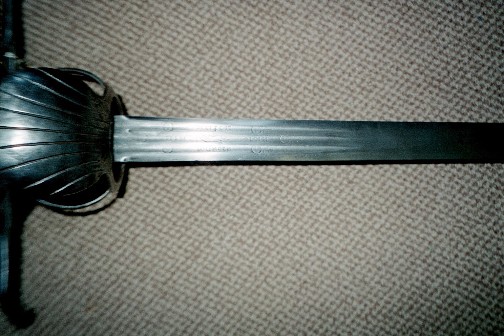 The
fifth and the sixth swords were the ones I was looking for. Dr. Beglinger
moved me up to the other floor, and there they were, too beautiful
for words [see the large image above]. The first was a German longsword,
circa 1600. The blade was long and had three small fullers about 1/6
down the length of the blade. [See sketch 137]. The blade had no sharp
edge, no sharp point, and as far as I could tell it seemed to have
been that way originally --but perhaps they were just polished down.
"Solengen" was stamped on the ricasso. The hilt was magnificent,
with clamshells plates covering the hand, and nice looking "S"
shape quillons. Over all, this entire sword was 129cm long and so
light! The
fifth and the sixth swords were the ones I was looking for. Dr. Beglinger
moved me up to the other floor, and there they were, too beautiful
for words [see the large image above]. The first was a German longsword,
circa 1600. The blade was long and had three small fullers about 1/6
down the length of the blade. [See sketch 137]. The blade had no sharp
edge, no sharp point, and as far as I could tell it seemed to have
been that way originally --but perhaps they were just polished down.
"Solengen" was stamped on the ricasso. The hilt was magnificent,
with clamshells plates covering the hand, and nice looking "S"
shape quillons. Over all, this entire sword was 129cm long and so
light!
 The
balance just seemed right. I never understood it when someone would
say, "It's just there" in regard to the feel of a good sword,
but now I do. This sword really did feel "just there", but
I could also feel that it had a "just wanting to thrust through
someone's head and chop off their arm" feeling. Holding it, its
quickness and tip control felt outstanding, yet at about 2-3lbs, to
me this sword seemed like it may have been able to deal out some devastating
cutting wounds. If only I had brought a raw pork shoulder…. Bidding
starts at $7000. The
balance just seemed right. I never understood it when someone would
say, "It's just there" in regard to the feel of a good sword,
but now I do. This sword really did feel "just there", but
I could also feel that it had a "just wanting to thrust through
someone's head and chop off their arm" feeling. Holding it, its
quickness and tip control felt outstanding, yet at about 2-3lbs, to
me this sword seemed like it may have been able to deal out some devastating
cutting wounds. If only I had brought a raw pork shoulder…. Bidding
starts at $7000.
 The
last sword I researched was my favorite of the group. It was an Italian
long sword with side-rings dated to 1570. Bidding starts at $5000.
It was about 118cm long, the hilt being a bit longer, and the blade
a bit shorter compared to the German one. The blade had two fullers
along the first third and the blade tapered down almost to a point,
but was a little rounded off. This blade also had no sharp edge; it
was completely blunt (by design?) [See sketch 130]. The hilt was beautiful.
The decorative artwork around the (loose) pommel, cross, and rings
made it even more a pleasure to handle and behold. The balance point
was very close to the hilt making the thing feel as quick as lightning.
I transitioned through some guards, because I just had to. It flowed
like water. It also screamed "cutter" to me. It felt like
it would have no problem cutting a man in two. If the hilt weren't
so loose, I think I would have ran off with it. You got off easy this
time Dr. B… The
last sword I researched was my favorite of the group. It was an Italian
long sword with side-rings dated to 1570. Bidding starts at $5000.
It was about 118cm long, the hilt being a bit longer, and the blade
a bit shorter compared to the German one. The blade had two fullers
along the first third and the blade tapered down almost to a point,
but was a little rounded off. This blade also had no sharp edge; it
was completely blunt (by design?) [See sketch 130]. The hilt was beautiful.
The decorative artwork around the (loose) pommel, cross, and rings
made it even more a pleasure to handle and behold. The balance point
was very close to the hilt making the thing feel as quick as lightning.
I transitioned through some guards, because I just had to. It flowed
like water. It also screamed "cutter" to me. It felt like
it would have no problem cutting a man in two. If the hilt weren't
so loose, I think I would have ran off with it. You got off easy this
time Dr. B…
|

